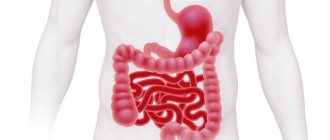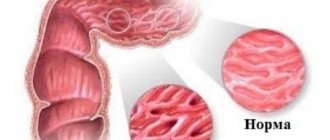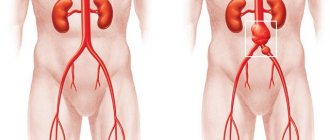What should you know about the disease?
Blood, as you know, has the property of clotting. In medicine, this process is called coagulation. This is a very important function, without which any person, after receiving wounds, would lose all his blood and, accordingly, die. On the other hand, coagulation promotes the formation of clots over time, otherwise known as thrombi. According to experts, they can form in absolutely any part of the body. For example, when they enter an intestinal artery, blood clots consistently clog its lumen, thereby preventing normal nutrition of a certain area of the organ. As a result, tissue necrosis in the intestine is observed. This disease is called thrombosis (mesenteric) of the intestine. In particularly serious cases, it can be fatal.
Mesenteric intestinal thrombosis is a disease that occurs due to obstruction of the superior, celiac or inferior mesenteric artery. This pathology often causes changes in blood circulation in the digestive tract. According to experts, this disease is equally common among women and men, but it is especially common in older people.
Symptomatic picture
The acute type of thrombosis occurs when a large thrombus suddenly enters the vessel. This process leads to the appearance of severe pain. In this case, the localization can be different: on the right in the appendix area, in the umbilical area or on the left in the lower abdomen.
After some time, diarrhea occurs. Blood streaks are observed in the impurities. Against the background of dehydration and low blood pressure, some symptoms arise in the form of:
- weakness;
- confusion and loss of consciousness;
- sudden blanching of the skin.
Over the course of 6-12 hours, the pain gradually subsides. But at the same time the patient feels worse and worse.
Then the last stage is observed, which is accompanied by:
- nausea and repeated vomiting;
- increase in temperature values;
- bloating, constipation, lack of gas discharge.
In chronic conditions, the whole process occurs differently.
The first stage is observed first. The patient is not worried about anything. Thrombosis can only be seen with a contrast x-ray.
Then the second stage is formed. After eating, the pain intensifies even more. Against this background, there is a loss of appetite. The intestines and stomach are gradually freed. At this time, the patient feels relief.
At the third stage, the pain is constant. The skin becomes dry. Regular diarrhea and bloating occur.
The fourth stage is considered the most severe. Symptoms progress rapidly further. Gases stop passing, the pain becomes stronger, and the body temperature rises sharply.
Etiology
Unfortunately, today absolutely no one is immune from this disease. However, doctors name a number of predisposing factors that primarily provoke the development of a pathology such as intestinal thrombosis. The reasons may be as follows:
- Atherosclerosis (vascular disease characterized by the sequential formation of plaques, the rupture of which leads to the formation of blood clots).
- Myocardial infarction.
- Hypertension (high blood pressure).
- Thrombophlebitis (an inflammatory process localized in the veins of the legs and accompanied by stagnation of blood).
- Endocarditis (inflammation of the inner lining of the heart, leading to the formation of blood clots).
- Sepsis (blood poisoning).
- Rheumatism (a disease affecting the connective tissue, resulting in the development of heart disease).
- Postpartum thrombosis.
Often, for example, thrombosis of the small intestine develops immediately after surgical manipulations on other organs. However, in this case, the patient has a greater chance of survival, since for some time after the operation he is under close medical supervision. In such situations, the specialist immediately makes a decision on treatment. An anticoagulant or any other drug that dilutes the clot is administered.
Prevention
Intestinal vascular thrombosis is much easier to prevent than to then cure and recover after surgery. The main ways to avoid the problem include:
- increasing physical activity, performing sets of exercises aimed at improving health;
- regular visits to the doctor. It is important to undergo regular examination, especially if a person is at risk or if he has symptoms of the disease;
- quit smoking. This habit provokes thrombophlebitis, inflammation of the vascular wall, and increased blood clotting;
- special attention should be paid to proper nutrition. Firstly, excess weight provokes increased stress on the vascular walls. Secondly, a number of products provoke the development of atherosclerosis (the root cause of blood clots). Therefore, the basis of the diet should be vegetables, fruits, and whole vegetables. But it is recommended to completely avoid sweets, animal fats, smoked foods, and spices, or at least reduce the consumption of such products to a minimum.
Read on the topic: Methods of myocardial revascularization - what is it?
Needless to say: in order to prevent intestinal thrombosis, as well as a number of other diseases of the abdominal organs, it is necessary to follow all of these recommendations in full, and not just some of them. If you follow such recommendations, then it is possible to completely prevent the development of pathology as such.
Primary clinical signs
Experts say that in the initial stages of development it can be very difficult to diagnose intestinal thrombosis. The symptoms listed below always act as an alarm bell and should alert everyone.
- Sudden pain in the abdominal area that occurs immediately after the next meal.
- Pallor of the skin, dry mouth, perspiration.
- Nausea and vomiting, bowel dysfunction (constipation or diarrhea).
- Flatulence.
- Low pressure.
- The presence of bloody discharge in the stool.
If the above symptoms appear, it is recommended to immediately seek help from a doctor. The sooner treatment begins, the higher the chances of successful recovery. Otherwise, the likelihood of complications developing is very high. After a blood clot blocks the lumen in the intestine, blood circulation in this area is disrupted. As a result, intestinal infarction is observed (spasm provoking tissue necrosis). As a result, peritonitis develops or major internal bleeding occurs into the peritoneum. In the absence of timely qualified assistance, the likelihood of death is very high.
Causes
Mesenteric thrombosis is characterized by obstruction of blood flow through the arteries and veins of the mesentery. This diagnosis is more often registered in older people, as it has a direct connection with cardiovascular pathology. Blood clots formed in places of damage to myocardial tissue can break off and move, resulting in thrombosis of the mesenteric vessels.
There are primary and secondary causes of mesenteric artery thrombosis.
Primary causes of thrombosis of mesenteric arteries:
- mitral valve stenosis;
- arrhythmia;
- aneurysm of the cardiac septum;
- myocardial infarction;
- injuries to the mesenteric vessels, for example, from a blow to the stomach.
When the heart muscle is damaged, a significant decrease in its contractility is observed. Slowing the speed of blood flow leads to the formation of an embolus. Most often, a blood clot enters the mesenteric arteries from the aorta, but in some cases it is possible to form a blood clot directly in the mesenteric vessels.
Secondary causes of mesenteric artery thrombosis:
- stenosis as a result of deposition of atherosclerotic plaques;
- heart failure with a pronounced drop in blood pressure;
- operations to remove a blood clot from the lumen of the aorta (when blood clots are removed from its cavity, blood rushes at high speed into the vessels of the lower extremities, bypassing the mesenteric arteries, under conditions of obstruction of which multiple clots and foci of intestinal necrosis are formed, while the main trunks of the arteries may not be affected).
A thrombus forms in the middle part of the abdominal aorta and spreads downward, causing the development of thrombosis of the superior mesenteric artery. This process can take place over a long period of time. As a result, damage to the inferior mesenteric artery is possible, as well as the development of thrombosis of the celiac trunk.
The main causes of mesenteric vein thrombosis:
- portal hypertension;
- purulent inflammatory processes in the abdominal cavity;
- sepsis;
- neoplasms;
- injuries.
In addition, there are risk factors, the presence of which significantly increases the risk of developing thrombosis of mesenteric vessels:
- thrombophilia;
- surgical interventions;
- injuries;
- long-term use of drugs that increase blood viscosity;
- prolonged immobilization, especially in the postoperative period;
- pregnancy and postpartum period;
- portal hypertension syndrome;
- cirrhosis of the liver;
- pancreatitis;
- diabetes;
- obesity;
- smoking.
The resulting blood clot can clog any vessel. The risk of damage to the mesenteric arteries or veins increases in the presence of severe bowel disease.
Main stages of the disease
Experts conditionally divide intestinal thrombosis into three stages of development:
- Intestinal ischemia. At this stage of the disease, the affected organ can still be restored. Patients are constantly accompanied by unbearable pain in the abdominal area and vomiting with bile. The stool becomes liquid.
- Intestinal infarction. The disease does not stand still in its development. As a consequence, some changes sequentially occur in the affected organ, as a result of which intoxication of the entire organism is observed. Loose stools give way to constipation, and now blood can be found in the stool. The pain in the abdominal area becomes unbearable, the skin turns pale and then acquires a bluish tint.
- Peritonitis. At this stage, the body is clearly poisoned by toxins, and disturbances in the functioning of the circulatory system occur. The pain may stop temporarily, but it is replaced by quite severe vomiting, and stool becomes literally unpredictable. Inflammation only intensifies over time. Very soon paralysis occurs, resulting in stool retention. There is hypotension and a slight increase in body temperature.
Symptoms and stages of thrombosis of mesenteric arteries
The clinic develops depending on the stage of mesothrombosis. The acute period begins with the appearance of precursors (as in a pre-infarction state) - abdominal toad. It manifests itself: pain, diarrhea. The pain syndrome begins in the navel area and spreads throughout the abdomen. It manifests itself as sharp spasms, cramps, mainly after eating. The severity of pain can be moderate to severe. More often, blockage appears without warning, suddenly. In this case, the symptoms depend on the stage of the process.
Ischemic stage (up to 12 hours from the moment of occlusion)
Insufficient blood circulation is compensated by additional arteries. Metabolic processes in tissues begin to slow down, dystrophic changes occur in the epithelial cells of the intestine. Peristalsis is disrupted, and the production of enzymes that contribute to the breakdown of food is reduced. The stage is characterized by unbearable pain in the abdominal cavity - contractions.
People take a forced pose - bend over, bringing their legs to their stomach. Loose stools with blood appear - ischemic bowel movement caused by severe hypoxia. Severe nausea gives way to vomiting bile streaked with blood. As the process progresses, the vomit acquires the smell of feces.
Stage of infarction (up to 18 hours from occlusion)
There is a disruption in the functioning of the intestine, the tissues undergo necrosis. When signs of intestinal infarction appear, collateral vessels can no longer compensate for insufficient blood circulation. Severe intoxication occurs. The pain syndrome decreases and appears only upon palpation of the abdomen. Diarrhea stops, giving way to constipation. There is a weak pulse and unstable blood pressure. The reduction in symptoms is associated with necrotization of nerve endings.
Stage of peritonitis (36 hours after occlusion)
Necrotic tissue begins to melt, inflammation begins, the intestinal walls rupture, its contents spread throughout the abdominal cavity. The patient's condition deteriorates sharply. The pain returns, spreading throughout the abdomen. Any movement causes increased pain, so patients lie motionless in the fetal position, moan and delirium, and have difficulty answering questions.
As peritonitis progresses, the manifestation of symptoms decreases (imaginary improvement). The pain syndrome subsides, euphoria and prostration appear. The patient's facial features become sharper. Urine and stool are absent, bowel sounds are not audible, and the symptom of peritoneal irritation (Shchetkin-Blumberg) is determined. The mucous membranes of the oral cavity are dry.
In the last (terminal stage) the functions of all organs and systems are disrupted. The skin takes on an earthy color, cold, sticky sweat appears, and the eyes become sunken. The stage may be accompanied by vomiting of intestinal contents. The abdomen swells (without muscle tension), and due to intoxication, a person can fall into a coma. Terminal stage mortality rate is 90%.
Important! A reversible condition is only the stage of ischemia, in which the functionality of the cells is completely restored.
How to independently diagnose intestinal thrombosis?
It is very important to constantly monitor the condition of your body. If you experience pain in the abdomen and bloody stool, you should immediately seek help from a doctor, as there is a possibility of a disease such as intestinal thrombosis. Symptoms may vary for each individual patient. So, some people's skin turns pale, their temperature rises to 38 degrees, hypertension appears, and then a sharp drop in blood pressure is observed. All these clinical signs should alert you. In this type of situation, it is recommended to call an ambulance. It is important to remember that any delay can literally cost your life. If a person does not go to the hospital with these symptoms, we can confidently say that the disease will end in death.
Prognosis and complications
With the development of thrombosis, destruction primarily affects the mucous membrane, ulcers form, and signs of necrosis appear. If treatment is not started at this stage, tissue breakdown occurs. The intestinal wall is destroyed, resulting in the contents entering the abdominal cavity. Inflammation develops, which can be fatal.
Thrombosis of the intestinal mesenteric vessels is a dangerous disease that can lead to the development of severe consequences. When providing assistance in the early stages of the disease, the patient's condition stabilizes within a few days; in the case of late surgical intervention, the prognosis worsens. If treatment is not timely, complications develop in almost all patients. That is why it is important to consult a doctor when the first symptoms appear, who will prescribe the necessary measures to diagnose intestinal thrombosis and carry out treatment.
The main diagnostic methods in a medical institution
When admitted to hospital with suspected intestinal thrombosis, the patient is usually subjected to a detailed diagnostic examination. It involves the following procedures:
- History and visual examination.
- Blood test for ESR level and leukocyte count (in case of thrombosis, these indicators are overestimated).
- Radiography.
- Computed tomography (allows you to examine the condition of internal organs in as much detail as possible).
- Diagnostic laparoscopy (the doctor makes a puncture on the skin, through which a tube with a camera at the end will be inserted, the image from which is displayed directly on the computer screen).
- Diagnostic laparotomy (performed when laparoscopy is not possible).
- Vascular angiography using a contrast agent (this test can check the degree of blockage of blood vessels).
- Colonoscopy.
- Endoscopy.
Diagnostics
The development of instrumental methods makes it possible to distinguish mesenteric thrombosis from other similar conditions during the day. The most informative methods are:
- angiography - X-ray examination of vessels with contrast - thrombosed areas are simply not visible, there is no venous phase or reduced outflow;
- X-ray of the intestine - fluid levels in the intestinal loops are visible, which change when turning and changing body position;
- general blood test - a sharp increase in the number of red blood cells is detected, characteristic only of this condition;
- ECG - a similar clinical picture often occurs with acute myocardial infarction;
- consultation of related specialists if a perforated gastric ulcer, acute pancreatitis, cholecystitis, appendicitis is suspected.
A combination of examinations allows us to establish an accurate diagnosis.
Conservative therapy
When a patient enters the hospital, the doctor first assesses at what stage of development the intestinal thrombosis is. Treatment through conservative methods is usually used if the disease has not begun to progress. Here are used:
- A parenteral method of administering anticoagulants, the main purpose of which is to thin the blood. The most commonly used drug is Heparin and some of its analogues.
- Injections of thrombolytics and antiplatelet agents (medicines “Trental”, “Reopoliglyukin”, “Hemodez”).
Despite the fairly high mortality rate from this disease, if treated in a timely manner, there is a good chance of a complete recovery for the patient.
Treatment methods
The treatment method for intestinal thrombosis directly depends on the stage of the disease and the degree of damage to the vascular walls of the intestine. At an early stage, conservative treatment is sufficient, which consists of two stages:
- inhalations, taking oral anticoagulants. The majority of drugs are heparin-based;
- thrombolytic injections.
If the patient’s condition is already considered urgent, it is necessary to take urgent measures to stabilize it, then surgical intervention may be necessary. The reason is that conservative therapy will be sufficient only when the blood flow is partially impaired. If blood flow through an artery is completely blocked, immediate surgery is necessary. The operation involves:
- removal of the damaged area of the intestine, which has already succumbed to necrotic changes;
- inserting a catheter into the vessel to ensure uninterrupted blood supply;
- removal of the blood clot itself.
Before prescribing treatment, a diagnosis of intestinal thrombosis is necessary. This requires a computed tomography scan. The examination helps to identify the degree of damage to the vascular walls and the location of the formed blood clot. Without a preliminary examination, treatment cannot be prescribed, nor can surgery be performed.
Surgery
If mesenteric intestinal thrombosis progresses, or the disease cannot be overcome with medication, the doctor prescribes surgery, and drug therapy acts as an additional treatment.
In the case of intestinal ischemia, the disease rarely goes away on its own, however, as a preventive measure, antibiotics are recommended to remove toxins from the body.
The operation involves the removal of damaged organ segments and subsequent stitching of healthy tissues together. In some cases, bypass surgery is additionally required. During this procedure, the specialist creates a “bypass” around the blocked vessel so that the blood can move further.
If thrombosis of intestinal vessels occurs in an acute form, surgical intervention is also prescribed. The doctor independently determines what exactly needs to be done (remove a blood clot, perform angioplasty, bypass surgery, etc.). These manipulations help stop the development of the disease, subsequently tissue necrosis does not appear.
Hospitalization of the patient
Mesenteric thrombosis is treated in the clinic, namely in the surgical department. The success of treatment depends on the stage of advanced disease at which the patient is admitted to the hospital.
The detection and treatment procedure looks like this:
- Urgent tests are taken from the patient. This is necessary to assess coagulation and leukocyte levels in the blood;
- An x-ray is taken, from which the doctor determines the fluid level in case of small intestinal obstruction;
- Angiography is a good diagnostic tool. On an angiogram with arterial thrombosis, a pronounced contrasting trunk will not be noticeable;
- An effective way to determine the degree of development of mesenteric thrombosis in the intestine is minimally invasive surgery (diagnostic laparoscopy). A small puncture is made in the abdominal area, through which the doctor can examine the abdominal organs. In this way, the most accurate diagnosis can be left;
- If diagnostic laparoscopy is impossible for some reason (due to lack of equipment), diagnostic laparotomy is performed. This is a kind of the beginning of a medical operation;
- If only a couple of hours have passed since the blockage, then during the operation there will be a chance to remove the thrombus from the lumen of the vein or mesenteric artery. If necrosis of the small intestine or gangrene has begun, it is resected;
- The doctor determines the method of performing the operation individually for each patient. After the operation, it is necessary to take medications that dilate the mesenteric vessels, thin the blood, antibiotics, as well as medications that cleanse the body of toxins.
Note! After removing part of the intestine, its patency will be restored fairly quickly, which gives hope for stabilization of the health condition.
Rehabilitation
After all surgical procedures, the patient usually spends some more time in the hospital. Over the next two weeks, he is contraindicated for any physical activity. Otherwise, you can provoke a hernia.
During rehabilitation, doctors recommend bed rest and, if necessary, massage the abdomen yourself, lightly stroking it clockwise.
It is very important to follow all recommendations from doctors. After all, only in this way can you forget forever about such a problem as intestinal thrombosis.
After surgery, it is equally important to adhere to a dairy-vegetable diet. The diet should consist of rice porridge, fruits, lean boiled meat/fish, and dairy products. All canned and smoked foods, alcoholic beverages, garlic and onions are prohibited. It is not recommended to drink whole milk in the first month after surgery, so as not to provoke digestive upset.
In conclusion, it should be noted that timely treatment of this disease almost always results in complete recovery. You should not delay visiting a doctor and subsequent therapy.











